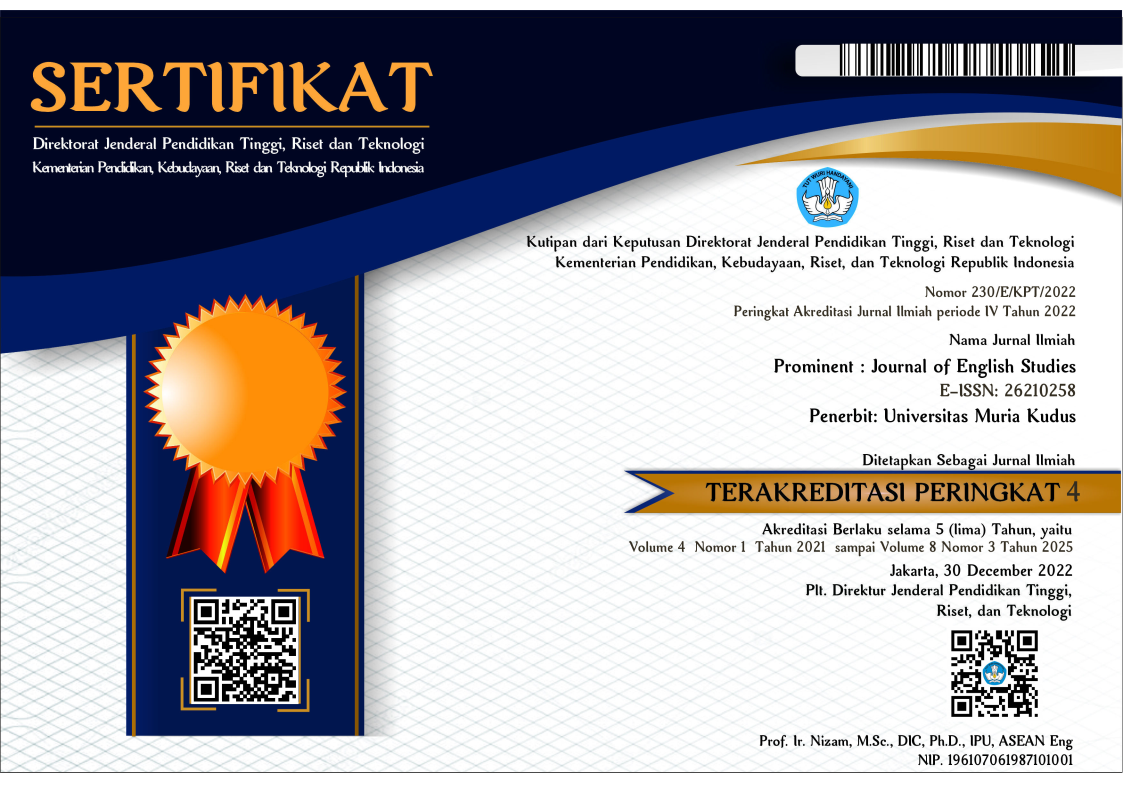TIME TOKEN TECHNIQUE TO IMPROVE THE STUDENTS’ LEARNING ACTIVITY AND COMMUNICATIVE COMPETENCE
Abstract
ABSTRACT
The purpose of this research is to know the effectiveness of Cooperative Learning Time Token towards student’s learning activity and Communicative Competence in speaking English. This research uses Classroom Action Research procedures. The research consists of two cycles, each comprises four phases, namely planning, acting, observing and reflecting. The subject of the research is the students of SMK N 2 Temanggung semester 1 2019/2020. To get data, the writer uses Brown’s Scale of Test of Spoken English. While for students’ activities, the writer uses a set of observation sheet to observe the activity of the students in class. The research reveals that the uses of Time Token technique in English class has increased the students’ Learning activities from 68 % in Pre-cycle to 78% in cycle 1 and 80 % in cycle 2. The Communicative competence in speaking English has increased from 74 to 78 in cycle 1 and 81 in cycle 2
Key words : Time Token, students’ activity and students’ communicative competence
Keywords
Full Text:
PDFReferences
REFERENCES
AS Hornby, (1973). Oxford Advanced Leaner’s Dictionary of Current English: London:OxfordUniversity Press
Brown, H.D. (2004). Language Assessment: Principles and Classroom Practice. San
Fransisco: Fransisco State University
Canale, M (l983) From communicative competence to communicative language pedagogy. In: Richards J, Schmidt R (eds) Language and Communication. London: Longman
Djumarah, S.B. (2013). Strategi belajar mengajar. Rineka Cipta, Jakarta
Hamalik, Oemar. (2013). Proses Belajar Mengajar. Jakarta : PT Bumi Aksara.
Henry Guntur Tarigan, (1990).Pengajaran Kompetensi Bahasa:Bandung: Angkasa
Jason Beale, Is Communicative Language Teaching A Thing Of The Past?, retrieved from http://www.jasonbeale.co m/essaypages/clt_essay.html.
On March 15 Maret 2019 at 17.14 WIB.
Sandra Savignon, (1983).Communicative Competence: Theory and Classroom Practice Massachusetts: Addison Wesley Publishing
Sardiman, A. (2011). Interaksi dan Motivasi Belajar Mengajar. Jakarta: Rajawali Pers.
Slavin, R. E. (2005). Cooperative Learning. Bandung: Penerbit Nusa Media.
Suprijono, Agus. (2015). Cooperative Learning. Teori dan Aplikasi PAIKEM. Yogyakarta: Pustaka Pelajar.
Sutikno, S. (2014). Metode & Model-model Pembelajaran. Lombok: Holistica.
Zainal Aqib. (2009). Penelitian Tindakan Kelas Untuk Guru. Bandung: Yrama Widya
www.teachingenglish.org.uk accessed on March 15 Maret 2019 at 20.14 WIB
DOI: https://doi.org/10.24176/pro.v4i1.5793
Refbacks
- There are currently no refbacks.
Prominent Journal of English Studies is licensed under a Creative Commons Attribution-ShareAlike 4.0 International License.
Dedicated to:

in Collaboration with APSPBI:





